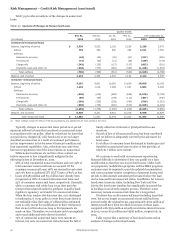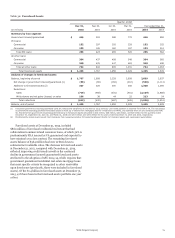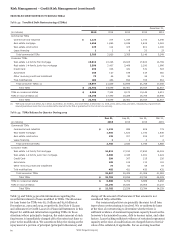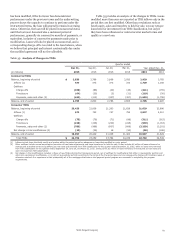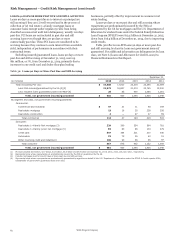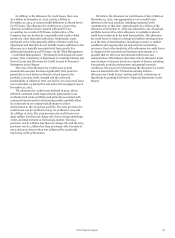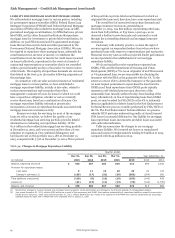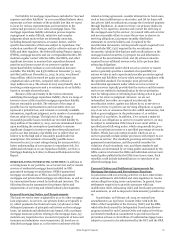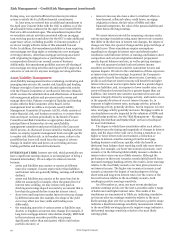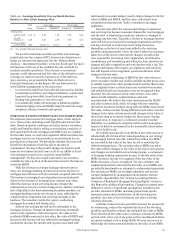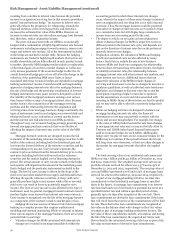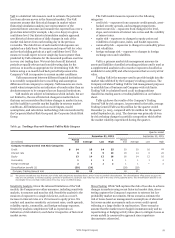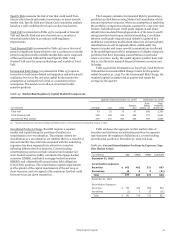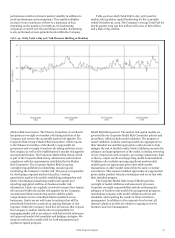Wells Fargo 2015 Annual Report Download - page 89
Download and view the complete annual report
Please find page 89 of the 2015 Wells Fargo annual report below. You can navigate through the pages in the report by either clicking on the pages listed below, or by using the keyword search tool below to find specific information within the annual report.
Our liability for mortgage repurchases, included in “Accrued
expenses and other liabilities” in our consolidated balance sheet,
represents our best estimate of the probable loss that we expect
to incur for various representations and warranties in the
contractual provisions of our sales of mortgage loans. The
mortgage repurchase liability estimation process requires
management to make difficult, subjective and complex
judgments about matters that are inherently uncertain,
including demand expectations, economic factors, and the
specific characteristics of the loans subject to repurchase. Our
evaluation considers all vintages and the collective actions of the
GSEs and their regulator, the Federal Housing Finance Agency
(FHFA), mortgage insurers and our correspondent lenders. We
maintain regular contact with the GSEs, the FHFA, and other
significant investors to monitor their repurchase demand
practices and issues as part of our process to update our
repurchase liability estimate as new information becomes
available. The liability was $378 million at December 31, 2015,
and $615 million at December 31, 2014. In 2015, we released
$159 million, which increased net gains on mortgage loan
origination/sales activities, compared with a release of
$140 million in 2014. The release in 2015 was primarily due to
resolving certain exposures and a re-estimation of our liability
based on recently observed trends.
Because of the uncertainty in the various estimates
underlying the mortgage repurchase liability, there is a range of
losses in excess of the recorded mortgage repurchase liability
that are reasonably possible. The estimate of the range of
possible loss for representations and warranties does not
represent a probable loss, and is based on currently available
information, significant judgment, and a number of assumptions
that are subject to change. The high end of this range of
reasonably possible losses exceeded our recorded liability by
$293 million at December 31, 2015, and was determined based
upon modifying the assumptions (particularly to assume
significant changes in investor repurchase demand practices)
used in our best estimate of probable loss to reflect what we
believe to be the high end of reasonably possible adverse
assumptions. Our estimate of reasonably possible losses
decreased in 2015 as court rulings during the year provided a
better understanding of our exposure to repurchase risk. For
additional information on our repurchase liability, see Note 9
(Mortgage Banking Activities) to Financial Statements in this
Report.
RISKS RELATING TO SERVICING ACTIVITIES In addition to
servicing loans in our portfolio, we act as servicer and/or master
servicer of residential mortgage loans included in GSE-
guaranteed mortgage securitizations, GNMA-guaranteed
mortgage securitizations of FHA-insured/VA-guaranteed
mortgages and private label mortgage securitizations, as well as
for unsecuritized loans owned by institutional investors. The
following discussion summarizes the primary duties and
requirements of servicing and related industry developments.
General Servicing Duties and Requirements
The loans we service were originated by us or by other mortgage
loan originators. As servicer, our primary duties are typically to
(1) collect payments due from borrowers, (2) advance certain
delinquent payments of principal and interest on the mortgage
loans, (3) maintain and administer any hazard, title or primary
mortgage insurance policies relating to the mortgage loans, (4)
maintain any required escrow accounts for payment of taxes and
insurance and administer escrow payments, (5) foreclose on
defaulted mortgage loans or, to the extent consistent with the
related servicing agreement, consider alternatives to foreclosure,
such as loan modifications or short sales, and (6) for loans sold
into private label securitizations, manage the foreclosed property
through liquidation. As master servicer, our primary duties are
typically to (1) supervise, monitor and oversee the servicing of
the mortgage loans by the servicer, (2) consult with each servicer
and use reasonable efforts to cause the servicer to observe its
servicing obligations, (3) prepare monthly distribution
statements to security holders and, if required by the
securitization documents, certain periodic reports required to be
filed with the SEC, (4) if required by the securitization
documents, calculate distributions and loss allocations on the
mortgage-backed securities, (5) prepare tax and information
returns of the securitization trust, and (6) advance amounts
required by non-affiliated servicers who fail to perform their
advancing obligations.
Each agreement under which we act as servicer or master
servicer generally specifies a standard of responsibility for
actions we take in such capacity and provides protection against
expenses and liabilities we incur when acting in compliance with
the specified standard. For example, most private label
securitization agreements under which we act as servicer or
master servicer typically provide that the servicer and the master
servicer are entitled to indemnification by the securitization
trust for taking action or refraining from taking action in good
faith or for errors in judgment. However, we are not
indemnified, but rather are required to indemnify the
securitization trustee, against any failure by us, as servicer or
master servicer, to perform our servicing obligations or against
any of our acts or omissions that involve willful misfeasance, bad
faith or gross negligence in the performance of, or reckless
disregard of, our duties. In addition, if we commit a material
breach of our obligations as servicer or master servicer, we may
be subject to termination if the breach is not cured within a
specified period following notice, which can generally be given
by the securitization trustee or a specified percentage of security
holders. Whole loan sale contracts under which we act as
servicer generally include similar provisions with respect to our
actions as servicer. The standards governing servicing in GSE-
guaranteed securitizations, and the possible remedies for
violations of such standards, vary, and those standards and
remedies are determined by servicing guides maintained by the
GSEs, contracts between the GSEs and individual servicers and
topical guides published by the GSEs from time to time. Such
remedies could include indemnification or repurchase of an
affected mortgage loan.
Consent Orders and Settlement Agreements for
Mortgage Servicing and Foreclosure Practices
In connection with our servicing activities we have entered into
various settlements with federal and state regulators to resolve
certain alleged servicing issues and practices. In general, these
settlements required us to provide customers with loan
modification relief, refinancing relief, and foreclosure prevention
and assistance, as well as imposed certain monetary penalties on
us.
In particular, on February 28, 2013, we entered into
amendments to an April 2011 Consent Order with both the
Office of the Comptroller of the Currency (OCC) and the FRB,
which effectively ceased the Independent Foreclosure Review
program created by such Consent Order and replaced it with an
accelerated remediation commitment to provide foreclosure
prevention actions on $1.2 billion of residential mortgage loans,
subject to a process to be administered by the OCC and the FRB.
Wells Fargo & Company
87



